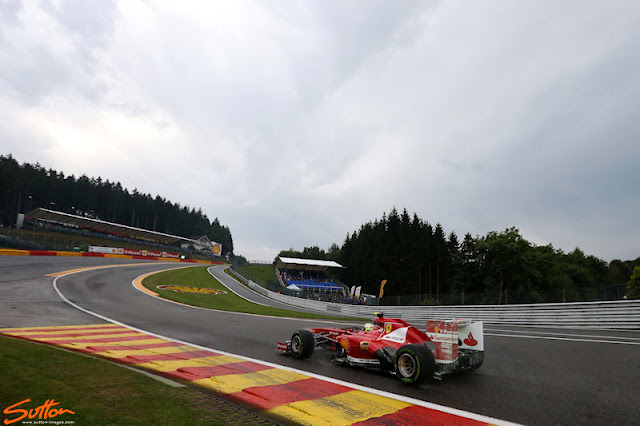Ferrari F138 Front Wing - Notice the top flap has been sliced away to reduce the amount of force being generated
Red Bull RB9 - Close up shows the vertical strakes added to the Mainplane and flaps to keep the airflow straight for the Strakes behind and stop rubber build up
Mercedes W04 Front Wing this time with detachable IR tyre cameras secured to the Cascade
Red Bull RB9 - detailed shot of the Front Wing
Mercedes W04 - Dual element Under Chassis Turning Vanes
McLaren MP4-28 - 3 tier under chassis Turning Vanes
Ferrari F138 - Triple element under chassis Turning Vanes
Ferrari F138 - New Rear Wing features a much shallower angle of attack for the Mainplane and Top Flap whilst the room needed for the Louvres has reduced their number to 2
Red Bull RB9 - Low downforce specification rear wing features a very shallow angle of attack for the Mainplane and Top Flap
Ferrari F138 - A more expansive view of the new rear wing also shows the much stubbier DRS actuator pod
Ferrari F138 - In action with the new front and rear wings
Sauber C32 in action sporting their DRD (Drag Reduction Device)
McLaren MP4-28 in action sporting the teams lower downforce rear wing
Force India VJM06 in action sporting a lower angle of attack on the rear wing
Mercedes W04 in action with Nico at the wheel, the car is sporting a hybrid rear wing with the new Endplates that have vortice reducing strikes on the outer edge whilst the Mainplane and Top Flap have been returned to their standard specification
Red Bull RB9 - As shown in these magnified images the new lower downforce rear wing has the angle of attack set so shallow that adding louvres would be ineffective. The endplates increase the rear wings aspect ratio and so when a wing is set at a higher AoA you want to reduce some of it's effectiveness as speed builds. A Wing set at the normal AoA with no Louvres creates much more drag as at the trailing edge the high and low pressures meet creating a spiraling vortice (Seen below in some of the images) this has an onward effect to the rest of the wing and causes drag. The Louvres allow the pressures to equalise more reducing this problem at high speed.
Ferrari F138 in action through Eau Rouge shows the team have covered the Rear Wing with Flo-Viz in order to assess if the information on track correlates with that showed in CFD and the Wind Tunnel
McLaren MP4-28 going through Eau Rouge whilst the track is producing spray gives us an idea of how some of the airflow moves around the car
Ferrari F138 from behind with their standard rear wing configuration in the damp shows how the vortices I mentioned above form. In the case of Ferrari their vortices are also manipulated by the trailing edge slats the team use on the endplates. You'll see on the Lotus below that the Ferrari vortices are much straighter signalling a better control over the drag in the region
Lotus E21 - DRD applied also shows the drag being produced at the rear wing end tips in the form of vapour trails
Lotus E21 - close up of the teams DRD
Sauber C32 - rearward view of the teams DRD installed on the car during FP1 along with the Spoon style rear wing
Sauber C32 - great image of the pipework for DRD being installed on the car before the engine cover is applied
Lotus E21 - Rearward bodywork shows a small triangular section on the floors edge guarding the tyre squirt slot
Red Bull RB9 - The team have applied Flo-Viz to the diffuser to check it's performance
McLaren MP4-28 - Close up detail shot of McLaren's Vortex Generators
MP4-28 - The team use a pitot tube array on the leading edge of the floor to assess the airflow in the region
Ferrari F138 Front Brake Assembly
Red Bull RB9 Front Brake Assembly
Red Bull RB9 - Front Wing and Nose detail shows the team have reverted to the FOM cameras in the rearward position
Caterham CT-03 - Giedo had an off during FP2 and damaged his Caterham luckily for us Sutton were there on hand to capture the underside of the car as it was craned off the recovery truck































